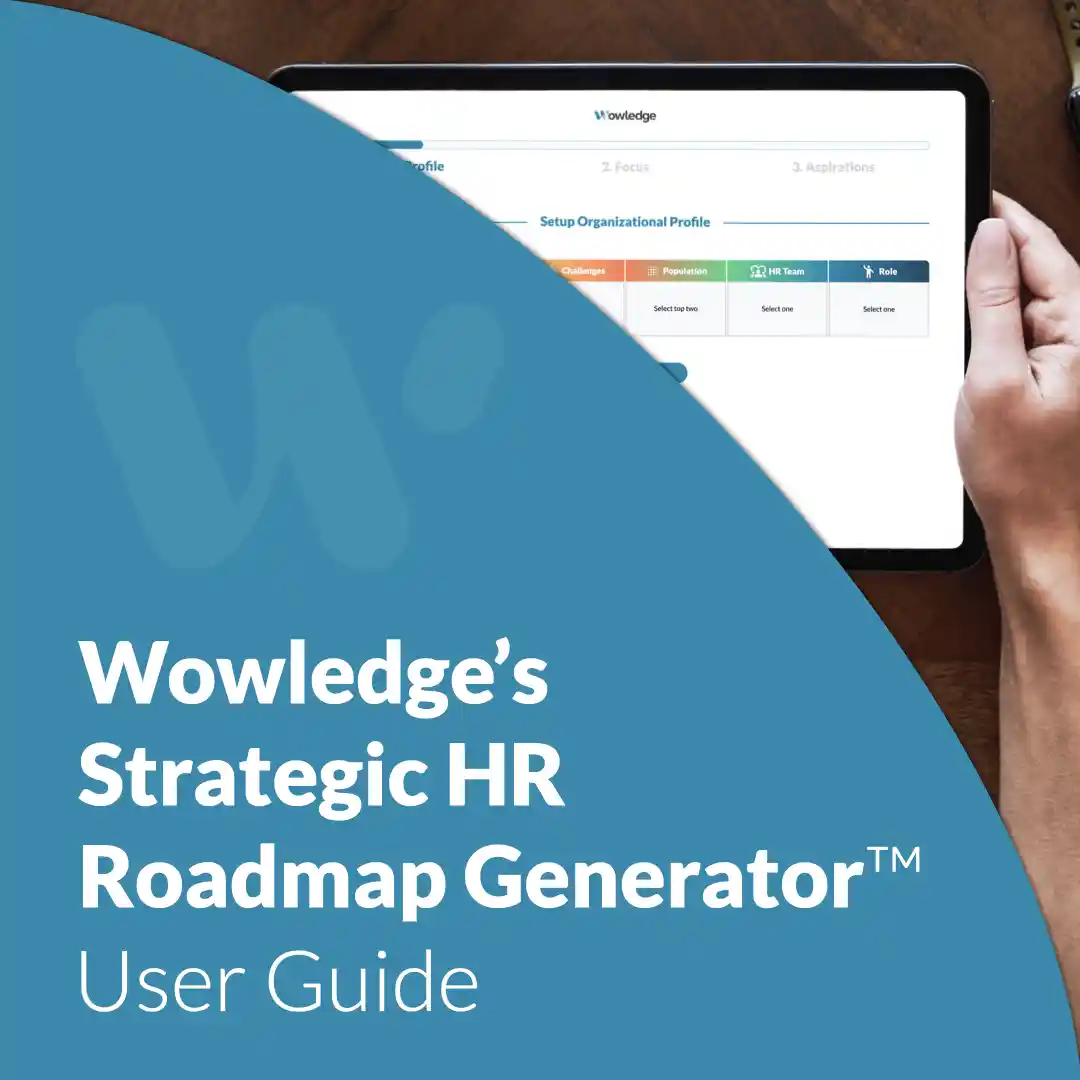Enjoy instant access to a scalable system of proven practices and execution-ready tools. Built to launch strategic HR programs 5X faster!
✓ Enjoy platform access
✓ Create your HR roadmap
✓ View open content in library
✓ Access dozens of practices:
⤷ The HR Strategy program
⤷ Explainers and deep dives
⤷ Supplemental guides
⤷ Insight articles
⤷ Weekly best practices
⤷ And more!
100% Free. No credit card required.
Wowledge’s intelligent Strategic HR Roadmap Generator™ enables any organization, regardless of size or sophistication level, to start charting its strategic HR journey quickly. The tool allows anyone with or without a human resources background to identify and prioritize strategic HR practices and initiatives to solve the company’s most pressing people-related challenges and opportunities.
The Strategic HR Roadmap is a blueprint that provides clear visibility over prioritized strategic HR programs, showcasing the appropriate level, sequence, and interrelation of these efforts. It produces primary and secondary focus areas, showing how to progress across different sophistication levels to move the organization forward effectively. The roadmap spans across short-, medium-, and long-term timeframes, giving a complete view of the journey ahead in strategic HR planning. The roadmap is dynamic, tracking progress and allowing flexibility to revise it as circumstances evolve.
The Strategic HR Roadmap Generator™ leverages real expert intelligence in proven human capital practices from decades of experience applied at hundreds of leading organizations combined with algorithmic technologies to create highly tailored recommendations. The tool creates a dynamic roadmap based on various customizable characteristics, providing suitable best practices that meet each organization where they are.
The strategic practices presented follow Wowledge’s Integrated Talent and Organizational Sustainment Framework. This holistic model distinguishes HR programs across five fundamental dimensions —Organizational Alignment, Organizational Adaptation, Talent Activation, Talent Acceleration, and Organizational Advancement— to maximize HR’s impact on the business.
The roadmapping process's starting point is defining an organizational profile across six categories. Selections within each category might vary each time the roadmap is set up as the company circumstances and priorities change.
Category selections and considerations:
Once options for all six categories have been selected, clicking “Generate roadmap” (external version) or “Start roadmapping” (registered member version) triggers the generative process to produce a customized roadmap that allows further interaction to confirm recommendations.
Companies need to prioritize their efforts and resources to be effective by focusing on a handful of areas at a time per roadmap. The Focus Areas reflect the types of strategic HR programs that will be relevant for an organization to concentrate on to solve the challenges they face, their context, and background makeup. Based on the relative importance associated with their organizational profile, the system classifies these programs into “Primary” and “Secondary” focus areas.
Sample Prioritized Focus Areas
The overall objective of this step in the roadmapping process is to confirm the focus areas to be included in the roadmap. While the system leverages experience and benchmarks from other companies with similar organizational profiles and complexities to make recommendations, each organization is unique.
Tasks and considerations:
If further instruction or a more detailed approach is needed, a comprehensive step-by-step guide to confirming priorities and involving stakeholders is available in “Establishing a Core Talent Management Strategy to Set Priorities and a Strategic Roadmap,” a Supplemental Guide freely open to all Wowledge members.
At Wowledge, best practices needed to build or enhance strategic HR programs are structured across three levels of progression —Core, Advanced, and Emerging— to provide organizations the ability to identify where they are in the continuum, what practices they have already in place, and which they aspire to implement next. Based on their organizational profile selections, the system will intelligently infer the level the company should target next. Since progression status varies significantly from company to company, recommended level and individual practice selections should be refined by marking those the organization has not yet put in place and, therefore, can become part of their roadmap.
Sample Selected Aspiring Practices to Target
Tasks and considerations:
Note for registered members: practice selections using the roadmapping tool are synchronized across the user experience. For example, outside the roadmap tab, when reviewing progressions using the “Explore Program Packages” navigation functionality, the same practice selections will be reflected for each program progression as in the roadmap view.
A roadmap with an appropriate number of practices will be doable and ultimately allow the assigned team to make adequate progress throughout the planning period. Defining an attainable duration for the entire roadmap, with yearly being a typical overall timeframe, is essential. The name of the roadmap can be modified to reflect this type of definition (e.g., 2026 Roadmap). Initiatives are classified into three time horizons to prioritize efforts further. The specific time ranges for these classifications will vary for each company based on their improvement urgency, resources available, and other conditions. In the case of a company with a small team setting its improvement cycle to one year, the NOW stage could be set to be accomplished within the first 3-6 months and the NEXT phase for the subsequent part of the year, with LATER initiatives potentially being pushed into the following year.
Sample Generated New Roadmap
Tasks and considerations:
The Strategic HR Roadmap offers a comprehensive framework that enables organizations to quickly get started on the improvement initiatives that will be most relevant for the company. It allows the HR team to become more strategic and proactive with a clarity of vision and direction that ensures investments in human capital are deliberate. The roadmap should be maintained as a living document, allowing for agile responses to changing conditions in alignment with business needs as they evolve.

Enjoy instant access to a scalable system of proven practices and execution-ready tools. Built to launch strategic HR programs 5X faster!